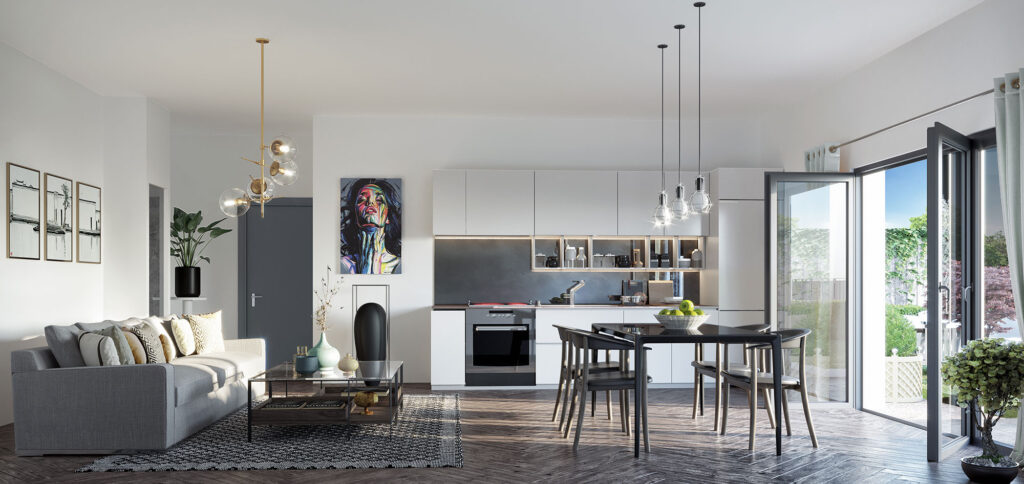Are you having trouble selling your properties or communicating about your programs? 3D modeling is the solution to convince customers and investors to take the plunge.
Virtual tours, photorealistic 3D images and real estate models have become must-haves for all industry professionals.
As this technology is constantly evolving, architectural software is multiplying, offering more breathtaking renderings than ever before. Would you like to take advantage of this to win more contractsand boost your business?
Let's find out how 3D modeling and virtual tours work in the real estate sector.
3D modeling for real estate projects: what are the advantages?

3D modeling, and especially virtual tours, are full ofadvantages for all real estate professionals, but also for buyers. These tools are revolutionizing the real estate industry, reducing many costs and optimizing the customer experience.
Cost reduction
For properties to be built or under construction, 3D tools can help reduce construction costs by preventing errors. In fact, three-dimensional visualization makes it possible to :
- Detecting design errors ;
- Facilitate collaboration and exchanges between team members (designers, architects, contractors, craftsmen);
- Preview the benefits of certain materials and finishes.
These upstream checks reduce wasted time and misunderstandings, and help to clarify the expectations of each stakeholder. All you have to do is show the site manager your expectations and the craftsmen the desired results, for faster, more efficient implementation. The result is lower construction costs and greater profitability for your project.
As far as real estate agencies are concerned, 3D modeling helps reduce the cost of visits and customer acquisition. In fact, this technology improves real estate agency operations by reducing the number of visits.
Offering an online catalog of virtual visits will save your teams long preparation times, travel time and visit times. This considerable time-saving translates into real savings for your real estate agency.
What's more, the presence of virtual visits also makes it possible to sort out the serious profiles from the uninformed prospects, reducing long phone calls and recurring trips.
With all this time saved, you can invest in high value-added actions: new mandates, customer relations, etc.
Improving the customer experience
The real estate sector has evolved considerably thanks to technology. Real estate professionals have benefited, but so have buyers and tenants. In fact, the customer experience has reduced the time it takes buyers to find a property.
On websites and online real estate ads, they can refine their initial selections thanks to the 3D visuals available (virtual tours, photorealistic perspectives) before requesting a physical visit.
In fact, buyers prefer to buy or rent from real estate agents who offer this type ofcustomer experience. Any prospect can therefore freely :
- Discover the place at any time and from any place;
- Projecting space and interior design;
- Visiting property even when far away or unable to travel;
- Get information fast.
As a real estate agent, these advantages enable you to reduce rental vacancies.
For property developers, it's a way of showing off the potential of the future property, if it's still under construction.
This technique allows you toincrease your bookings and earn cash to complete your program. The advantage of using a 3D real estate tour is that it quickly arouses the customer's interest and enables him or her to :
- Get an idea of the benefits and advantages of the property;
- Get explanations for faster decision-making;
- Discover the property's full potential at your own pace.
For developers and real estate agents alike, virtual tours and other 3D tools are an excellent solution to the potential reluctance of buyers. These images offer a truly immersive experience, thanks to their attention to detail and quality.
This persuasiveness, however, is only possible through the use of high-performance software and advanced personalization.
3D real estate modelling: which tools to use?

The 3D software market meets the needs of professionals looking for quality 3D real estate renderings. Several software packages now offer advanced 3D visuals.
BIM and CAD software comparison: AutoCAD and Microstation
BIM and CAD are two different real estate 3D model design methodologies. BIM or Building Information System is a collaborative tool for creating and generating an intelligent digital model of the entire construction project.
It integrates a wide range of data: geometric information, nature of materials, energy performance. This enables BIM software to simulate information such as the building's energy consumption.
BIM software includes ArchiCAD, Revit, DynamoBIM and Microstation.
CAD refers to computer-aided design software. They can be used to create architectural elements such as 2D or 3D plans. CAD software is used for graphic design only, and does not include any building data or information.
Nevertheless, they are the most widely used tools for producing 3D real estate visuals. AutoCAD is essentially a CAD tool, although it is interoperable with Revit software.
Nevertheless, to impress buyers and extend your communication with 3D images, the use of software such as AutoCAD, 3ds Max or SketchUp is more than sufficient.
The importance of customization
Personalization is at the heart of many companies' strategies to attract and retain customers. The real estate world is no exception. Thanks to 3D technology, you can seduce your prospects with advanced personalization.
Customers are looking for the right property to meet their needs. By focusing on the personalization of your 3D models, you not only contribute to the immersive experience, but above all to creating an emotional connection between them and the property.
This is precisely the case with the 3D configurator. This tool enables your customers to visualize and personalize every aspect of a property (walls, finishes, furniture, interior design).
If you're a real estate agent, it can be used to show them a property's potential for redevelopment or renovation. If you're selling new-build properties, the configurator is essential to help prospects get to grips with the premises, and thus facilitate the buying decision.
As far as possible, therefore, every real estate player should use 3D tools in general. Not only will you boost your business, but you'll also improve your brand image through an optimized customer experience.
Work with 3D real estate modeling professionals.
Let's talk about your projects








